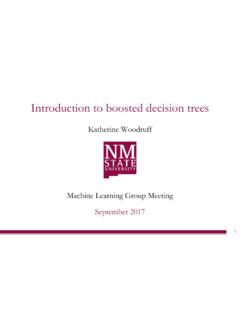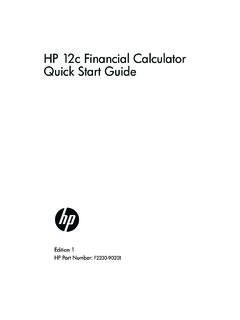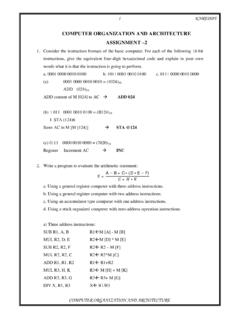Transcription of Ansys High Frequency Structure Simulator (HFSS) Tutorial
1 AnsysHigh Frequency Structure Simulator (HFSS) TutorialAugust 16, 20181 MARK JONESPACIFIC NORTHWEST NATIONAL LABORATORY8/21/18 August 16, 20182 AgendaOverview of HFSSC apabilities and key featuresExample measurement comparisonsCylindrical cavity tutorialEigenmodesolverParametric geometryCurvilinear elementsModal frequenciesQ-factorsField plotsField calculatorAugust 16, 20183 Overview of HFSSFull-wave Frequency -domain 3-D field solver based upon finite element methodIndustry-standard accuracyAdaptive meshing of arbitrary geometryFully parametric modelingOptimization and HPCM ulti-physics via AnsysWorkbenchWidely used for RF/microwave designAntenna design and platform integrationFilters and waveguide structuresElectronic packages and PCBsConnectors and transitionsEMC/EMIR adar cross-sectionIntegrated into AnsysElectronics DesktopPart of AnsysElectromagnetics
2 SuiteAugust 16, 20184 Recent Capability Additions to HFSSBase license includes multiple solversFrequency-domain 3D finite element solverFrequency-domain 3D finite element eigenmodesolverTransient finite 3D element solverFrequency-domain 3D integral equation solverFrequency-domain FEBI hybrid solverFrequency-domain planar integral equation solverLinear circuit solverBase license enables use of 4 processor coresHPC, Optimetrics, and Distributed Solver licenses increase computing capabilitiesHFSS offers two different interfaces to same solver to accommodate different workflows3D view (for CAD)3D Layout view (for ECAD such as Cadence, Mentor Graphics)
3 August 16, 20185 HFSS R19 User Interface within AnsysElectronics DesktopProject ManagerPropertiesMessage ManagerProgress Window3D Model Editor GraphicsRibbon / Toolbars3D Model Editor TreeAugust 16, 20186 Frequency -domain FEM Solution TypesEigenmodesolutionSolves for natural resonances of Structure based on geometry, materials, and boundariesProvides modal frequencies, unloaded Q-factors, and fieldsCan solve for up to 20 modes at onceDriven solutionPort or incident field used to excite the structureDriven modalmethod commonly used for RF/microwave designsDriven terminalmethod commonly used for multi-conductor transmission lines (no waveguides, symmetry boundaries, or Floquetports)
4 Provides S-parameters and fieldsAugust 16, 20187 Adaptive Mesh AlgorithmTetrahedral mesh automatically generated and refined below user-defined electrical lengthTetrahedral element shape conforms to arbitrary geometriesIterative algorithm solves fields and refines mesh until user-defined convergence threshold value is reachedCan be performed for set of user-specified frequencies (broadband adaptive meshing)Driven modal: S-parameter convergenceEigenmode: Frequency convergenceProduces graded mesh with fine discretization only where needed to accurately represent field behaviorEfficient use of computational resourcesTunes mesh to capture EM performanceAugust 16.
5 20188 Mesh ControlsMesh seeding allows user to directly influence initial meshReduce number of adaptive passesFocus mesh elements in critical areasNot required for accurate resultsCan improve field plotsSeeding radiation boundary can improve far-field dataLambda refinementEnsures that initial mesh is refined to fraction of electrical wavelengthElectrical size depends on solver basis orderZero: /10, First: /3, Second: 2 /3, Mixed: 2 /3 Initial geometric meshElectrical mesh after lambda refinementAugust 16, 20189 Curvilinear Mesh ElementsGlobal mesh approximation setting for all true surfaces in modelHigher order (curvilinear) elements used to represent the geometryPulls midpoints of tetrahedrasurfaces to true surfacePillbox resonator with analytical fR= GHz for TM010 modeDefault setting: GHzFiner segmentation: GHzCurvilinear elements.
6 GHz6024 error6140 error4966 errorAugust 16, 201810 Port Excitations for Driven SolutionsWave ports2D FEM solver calculates requested number of modes (treated as t-line cross-section)Solves for impedances and propagation constantsSupports multiple modesand de-embeddingSimple for closed t-linesMust allow room for fields of open t-linesMust touch external boundary or backed by conducting objectLumped portsUser-assigned constant impedanceUniform electric field on surfaceSingle TEM mode with no de-embeddingCan be internal to modelAugust 16.
7 201811 Frequency Sweeps for Driven SolutionsDiscrete sweepSolves adapted mesh at every frequencyMatrix data and fields at every frequencyFast sweepAdaptive Lanczos-Pad Sweep (ALPS) solver extrapolates rational polynomial function for electric field over specified range from center Frequency field solutionUsually valid over less than 10:1 BWMatrix data and fields at every frequencyInterpolating sweepSolves minimum number of frequencies to create rational polynomial fit for S-parametersUseful for very broadband S-parametersMatrix data at every frequencyAugust 16, 201812 FEM Solvers for Driven SolutionsDirect matrix solver is default techniqueExactly solves matrix equation Ax = bMulti-frontal sparse matrix solver to find inverse of A (LU decomposition)
8 Solves for all excitations b simultaneouslyIterative matrix solver is optional technique for driven solutionsReduces RAM usage and often runtimeSolves matrix equation Max = Mb where M is preconditionerBegins with initial solution and recursively updates solution until tolerance is reachedIterates for each excitation bMore sensitive to mesh quality, reverts to direct solver if it fails to converge0 BDtDJHtBE August 16, 201813 Boundary ConditionsCan be used to simplify geometry or make meshing more efficientMaterial properties for surfacesFinite conductivity (imperfect conductor)Perfect electric or magnetic conductorSurface approximations for componentsLumped RLCL ayered impedanceRadiationAbsorbing boundary conditionPerfectly matched layers (PML)FE-BI boundaryAny object surface that touches the background is automatically defined as Perfect E (perfect conductor)
9 BoundaryAugust 16, 201814 FEM Basis FunctionsBasis functions are n-order polynomials that describe how E-field varies along mesh elements edge, face, or volumeHierarchical basis functionsZero orfirst orsecond order basis functionsHigher-order elements have increased accuracy but more unknowns (6, 20, 45)Mixed order basis functionsZero andfirst andsecond order basis functionshp-FEM method refines element order p and element size hAutomatically distributes element order based on element size to optimize use of resourcesChoice of ideal basis function is problem dependentMixed order efficiency is comparable to or better than best of single order basis functionsAugust 16, 201815 Fields CalculatorTool for performing math operations on saved field dataE, H, J, and PoyntingdataGeometric, complex, vector.
10 And scalar dataUses peak phasor representations of steady-state fieldsPerform operations using model or non-model geometry Generate numerical, graphical, geometrical, or exportable dataReverse polish notationFrequently used expressions can be included in user library and loaded into any projectEliminates need to re-create expressions used across projectsData stackStack operationsContext selectionNamed expressionsCalculator functions sdsHE*}Re{21 vdvE2||21 August 16, 201816 Quality Factor of EigenmodeSolutionsProvided with solution data for each requested modeObtained from complex frequencyCan also be calculated using fields calculator = 2 ( ) dtgdsdQu2222 HHnH August 16, 201817 Example Comparison with MeasurementExcellent agreement for ADMX cylindrical cavityHFSS solution includes 12 modes in vicinity of TM010modeBlue markers indicate mode w








